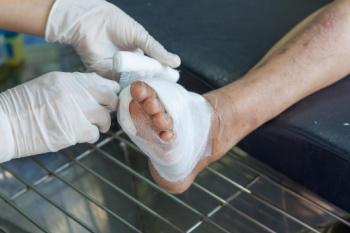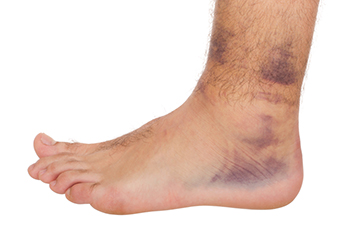February 2025
Treating Diabetic Foot Ulcers

Diabetic foot ulcers are open wounds that develop due to skin breakdown, often caused by pressure, friction, or injury. People with diabetes are particularly at risk of foot ulcers because conditions like peripheral neuropathy and poor circulation can impair sensation and healing in the feet. Diabetic foot ulcers can appear on the toes, soles, or ankles and may progress to deeper layers, involving muscles, tendons, or even bones. Untreated foot ulcers increase the risk of infection, potentially leading to severe complications, like gangrene or limb loss. A podiatrist plays a key role in managing diabetic foot ulcers by performing wound care, including debridement to remove damaged tissue and applying specialized dressings to promote healing. They may also recommend offloading techniques, such as using custom footwear or casts to reduce pressure on the affected area. Regular monitoring is essential to catch any early signs of infection or worsening ulcers. If you have foot ulcers related to diabetes, it is suggested that you make an appointment with a podiatrist for regular exams and necessary treatment.
Wound care is an important part in dealing with diabetes. If you have diabetes and a foot wound or would like more information about wound care for diabetics, consult with one of our doctors from Coral Desert Foot & Ankle. Our doctors will assess your condition and provide you with quality foot and ankle treatment.
What Is Wound Care?
Wound care is the practice of taking proper care of a wound. This can range from the smallest to the largest of wounds. While everyone can benefit from proper wound care, it is much more important for diabetics. Diabetics often suffer from poor blood circulation which causes wounds to heal much slower than they would in a non-diabetic.
What Is the Importance of Wound Care?
While it may not seem apparent with small ulcers on the foot, for diabetics, any size ulcer can become infected. Diabetics often also suffer from neuropathy, or nerve loss. This means they might not even feel when they have an ulcer on their foot. If the wound becomes severely infected, amputation may be necessary. Therefore, it is of the upmost importance to properly care for any and all foot wounds.
How to Care for Wounds
The best way to care for foot wounds is to prevent them. For diabetics, this means daily inspections of the feet for any signs of abnormalities or ulcers. It is also recommended to see a podiatrist several times a year for a foot inspection. If you do have an ulcer, run the wound under water to clear dirt from the wound; then apply antibiotic ointment to the wound and cover with a bandage. Bandages should be changed daily and keeping pressure off the wound is smart. It is advised to see a podiatrist, who can keep an eye on it.
If you have any questions, please feel free to contact one of our offices located in St. George and Kanab, UT, and Mesquite, NV . We offer the newest diagnostic and treatment technologies for all your foot care needs.
Link Between Cracked Heels and Thyroid Health

Cracked heels, also known as heel fissures, can sometimes be a sign of underlying thyroid issues. The thyroid gland plays a vital role in regulating metabolism and skin health. Hypothyroidism, a condition where the thyroid does not produce enough hormones, can lead to dry skin, which may result in cracked heels. Dryness, along with thickened or rough skin, can occur when thyroid dysfunction affects the body's ability to retain moisture in the skin. This makes the feet more prone to cracking, especially when combined with other factors, such as standing for long periods or wearing improper footwear. Treating the underlying thyroid condition can improve skin health, including preventing or reducing the occurrence of cracked heels and promoting overall foot well-being. If you have cracked heels, it is suggested that you consult a podiatrist who can offer you effective relief options, which may include prescribed medication.
Cracked heels are unsightly and can cause further damage to your shoes and feet. If you have any concerns, contact one of our doctors from Coral Desert Foot & Ankle. Our doctors can provide the care you need to keep you pain-free and on your feet.
Cracked Heels
Cracked heels appear unappealing and can make it harder for you walk around in sandals. Aside from looking unpleasant, cracked heels can also tear stockings, socks, and wear out your shoes. There are several methods to help restore a cracked heel and prevent further damage.
How Do You Get Them?
Dry skin is the number one culprit in creating cracked heels. Many athletes, walkers, joggers, and even swimmers suffer from cracked heels. Age and skin oil production play a role to getting cracked heels as well.
Promote Healing
Over the counter medicines can help, especially for those that need instant relief or who suffer from chronic dry feet.
Wear Socks – Wearing socks with medicated creams helps lock in moisture.
Moisturizers – Applying both day and night will help alleviate dryness which causes cracking.
Pumice Stones – These exfoliate and remove dead skin, which allows for smoother moisturizer application and better absorption into the skin.
Change in Diet
Eating healthy with a well-balanced diet will give the skin a fresh and radiant look. Your body responds to the kinds of food you ingest. Omega-3 fatty acids and zinc supplements can also revitalize skin tissue.
Most importantly, seek professional help if unsure how to proceed in treating cracked heels. A podiatrist will help you with any questions or information needed.
If you have any questions, please feel free to contact one of our offices located in St. George and Kanab, UT, and Mesquite, NV . We offer the newest diagnostic and treatment technologies for all your foot care needs.
Trail Running Shoes and Key Considerations

When buying trail running shoes, it is important to focus on several factors to ensure comfort, support, and durability. First, consider the type of terrain you will be running on. For rocky trails, look for shoes with a stiffer sole and more aggressive tread patterns that offer better grip and stability. If you will be running on smoother, well-maintained paths, a more flexible shoe may suffice. The fit of the shoe is also important. Make sure there is enough room in the toe box to allow for natural foot movement, and ensure the shoe is snug around the heel to prevent slipping. The level of cushioning is another consideration, as more cushioning is ideal for longer distances, while minimal cushioning may work better for faster, shorter runs. Finally, look for shoes that offer water resistance or drainage to keep your feet dry in wet conditions. If you enjoy running and want more information on choosing the best shoes, it is suggested that you make an appointment with a podiatrist, an expert on everything related to feet and ankles.
Finding a properly-fitting shoe is important in reducing injuries and preventing foot problems. For more information about treatment, contact one of our doctors from Coral Desert Foot & Ankle. Our doctors will treat your foot and ankle needs.
Proper Shoe Fitting
A common concern when it comes to foot health, having properly fitted shoes can help prevent injuries to the foot. Out feet affect our posture and gait, which in turn affects the biomechanics and overall bodily structure. With 33 joints, 26 bones, and over 100 ligaments, the potential for serious injury is much greater than one realizes. Although the feet cease growth in adulthood, they still change shape as they mature. Here are some factors to consider when it comes to investing in proper fitting shoes:
- Be sure the shoes fit correctly right away
- Ensure the ball of your foot fits comfortably in the widest portion of the shoes
- Even though they may look fashionable, improper fitting shoes can either create adverse conditions or exacerbate existing ones you may already have
- Walk along a carpeted surface to ensure the shoes comfortably fit during normal activity
Keeping in mind how shoes fit the biomechanics of your body, properly-fitting shoes are vitally important. Fortunately, it is not difficult to acquire footwear that fits correctly. Be sure to wear shoes that support the overall structure of your body. Do your feet a favor and invest in several pairs of well-fitted shoes today.
If you have any questions please feel free to contact one of our offices located in St. George and Kanab, UT, and Mesquite, NV . We offer the newest diagnostic and treatment technologies for all your foot and ankle needs.
Causes of Ankle Bruises

Bruising on the ankles can occur for various reasons, with trauma being the most common cause. Injuries such as sprains, strains, or falls can result in broken blood vessels, leading to visible bruises. However, bruising may also indicate underlying medical conditions. Conditions like diabetes, blood clotting disorders, or peripheral artery disease can affect circulation, making bruising more likely. Certain medications, such as blood thinners or steroids, can also increase the risk of bruising by affecting blood clotting or weakening blood vessel walls. Aging can also play a role, as skin becomes thinner and blood vessels lose their strength over time, making bruises more likely from minor impacts. Nutritional deficiencies, particularly a lack of vitamin C, vitamin K, or bioflavonoids, can also contribute to easy bruising. If your ankles have become bruised, it is suggested that you consult a podiatrist who can determine what the cause is, and offer appropriate treatment solutions.
Ankle pain can have many different causes and the pain may potentially be serious. If you have ankle pain, consult with one of our doctors from Coral Desert Foot & Ankle. Our doctors will assess your condition and provide you with quality foot and ankle treatment.
Ankle pain is any condition that causes pain in the ankle. Due to the fact that the ankle consists of tendons, muscles, bones, and ligaments, ankle pain can come from a number of different conditions.
Causes
The most common causes of ankle pain include:
- Types of arthritis (rheumatoid, osteoarthritis, and gout)
- Ankle sprains
- Broken ankles
- Achilles tendinitis
- Achilles tendon rupture
- Stress fractures
- Tarsal tunnel syndrome
- Plantar fasciitis
Symptoms
Symptoms of ankle injury vary based upon the condition. Pain may include general pain and discomfort, swelling, aching, redness, bruising, burning or stabbing sensations, and/or loss of sensation.
Diagnosis
Due to the wide variety of potential causes of ankle pain, podiatrists will utilize a number of different methods to properly diagnose ankle pain. This can include asking for personal and family medical histories and of any recent injuries. Further diagnosis may include sensation tests, a physical examination, and potentially x-rays or other imaging tests.
Treatment
Just as the range of causes varies widely, so do treatments. Some more common treatments are rest, ice packs, keeping pressure off the foot, orthotics and braces, medication for inflammation and pain, and surgery.
If you have any questions, please feel free to contact one of our offices located in St. George and Kanab, UT, and Mesquite, NV . We offer the newest diagnostic and treatment technologies for all your foot care needs.




